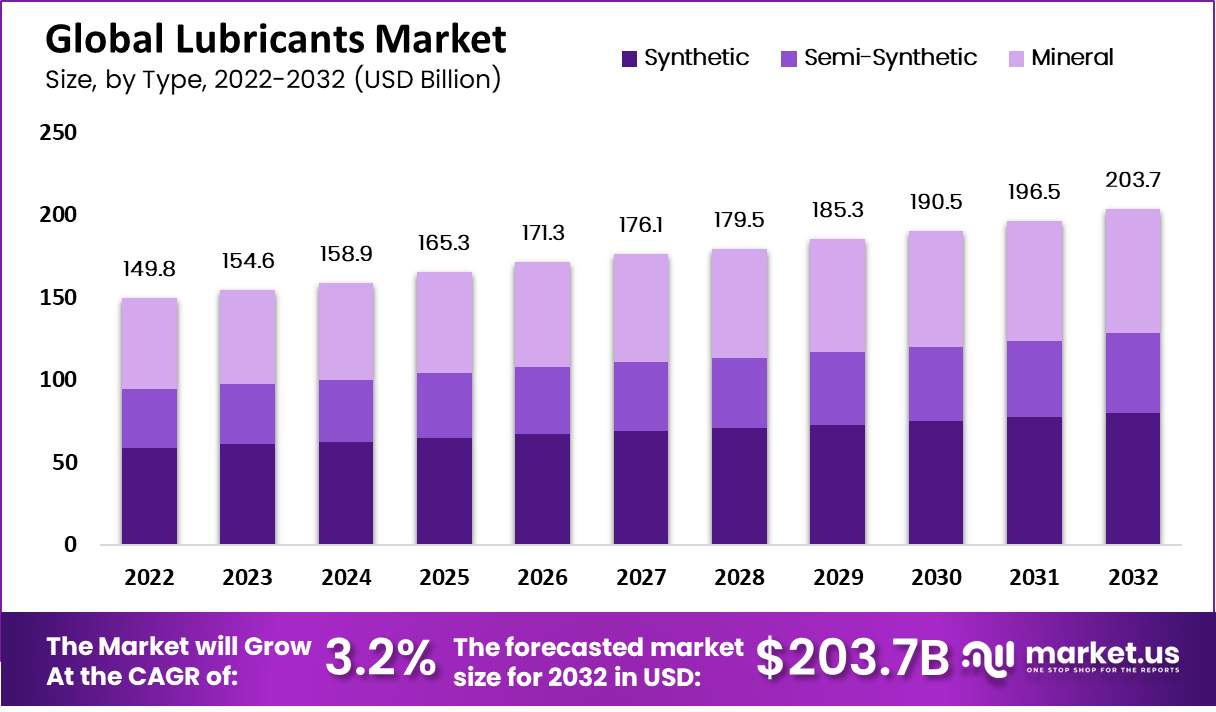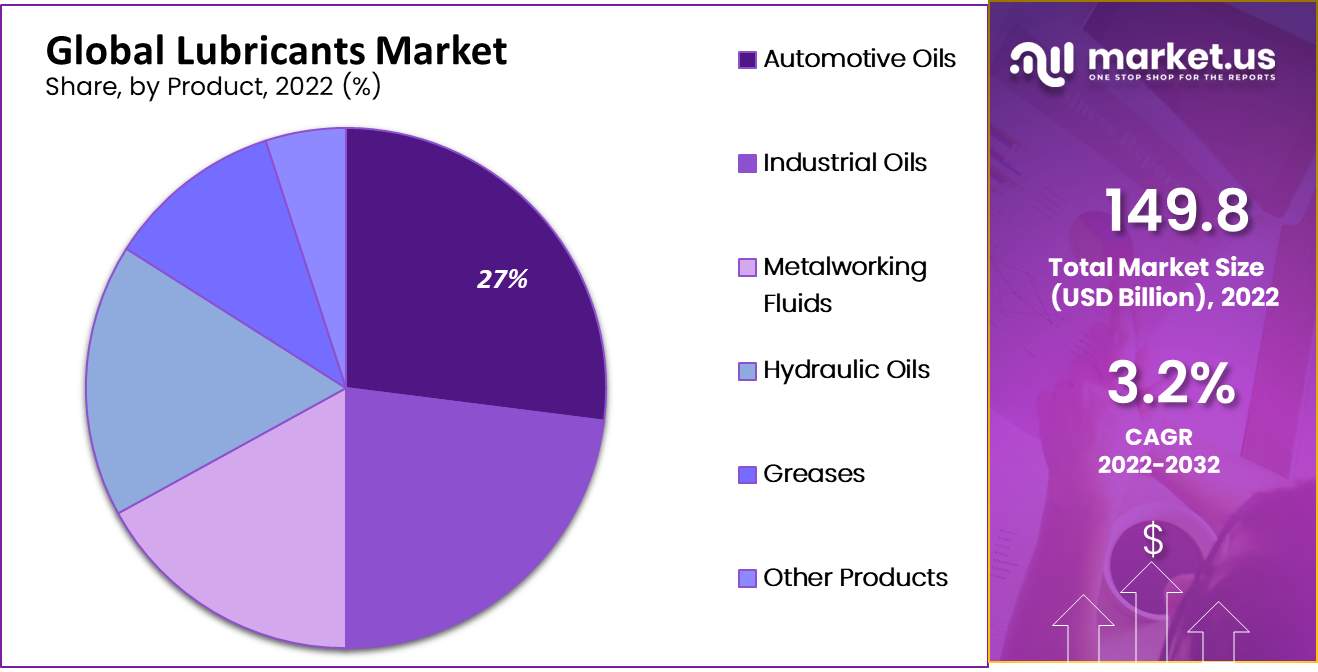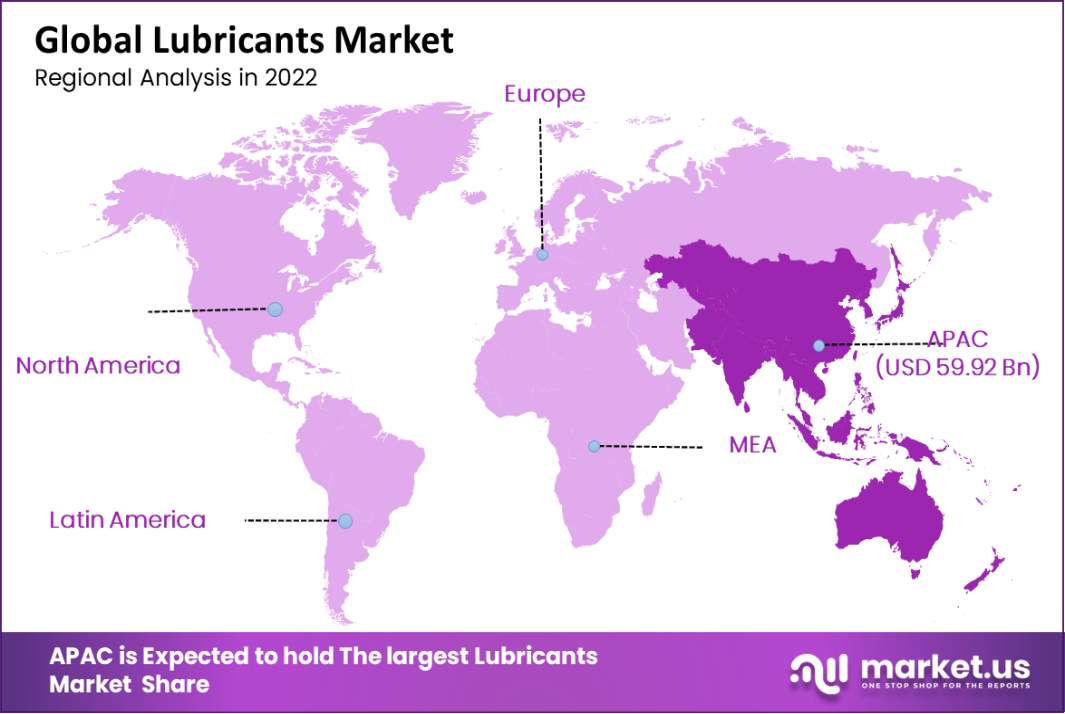Global Lubricants Market By Type (Mineral, Semi-Synthetic, and Synthetic), By Product (Automotive Oils, Industrial Oils, Metalworking Fluids, and Other Products), By End-Use Industry, By Region and Companies - Industry Segment Outlook, Market Assessment, Competition Scenario, Trends and Forecast 2023-2032
- Published date: Oct 2023
- Report ID: 14227
- Number of Pages: 242
- Format:
- keyboard_arrow_up
Quick Navigation
Report Overview
In 2022, the global lubricants market size accounted for USD 149.8 billion. This market is estimated to reach USD 203.7 billion in 2032 a CAGR of 3.2% between 2023 and 2032. A variety of lubricants used in automotive, industrial, marine, and other applications are included in the sizable and expanding worldwide lubricant market.

Lubricants are used to absorb heat produced by friction, minimize wear and friction between two surfaces in contact, and prevent corrosion and rust. The drivers for the growth of this market include rising demand for high-performance lubricants, and rising demand for energy-efficient automobiles.
Key Takeaways
- Market Growth: In 2022, the global lubricants market reached USD 149.8 billion with projected revenue reaching approximately USD 203.7 billion by 2032 at an astounding compound annual growth rate of 3.2% during this timeframe (i.e. from 2023-2032).
- Analysis by Type of Lubricants Market: When broken down by type, the market for lubricants encompasses synthetics, semi-synthetics, and minerals with synthetics holding the highest market share at 39.3%.
- By Product Analysis: Automotive-grade lubricants are designed for specific engine components like engines, gearboxes, and transmissions; industrial-grade ones may also be applied in hydraulic systems, gears, bearings, and compressors.
- Analysis by End-Use Industry: Markets for Lubricants have been divided into three broad end-use industries that use them; transportation, industry, and marine are the three biggest end-use markets that utilize Lubricants products.
- Drivers: Key factors driving demand for lubricants include an expanding global automotive sector, rising industrialization rates, and demand for efficient machinery operation. Furthermore, transportation sector expansion also drives increased lubricant usage.
- Restraints: Lubricants market companies face various obstacles such as stringent environmental regulations and an emerging electric vehicle trend that threatens traditional automotive lubricant demand in the future.
- Opportunities: Key drivers for market expansion include developing eco-friendly lubricants that comply with regulatory standards, and meeting an increase in industrial sector demands for high-performance lubricants.
- Lubricants market Trends: Major trends in the lubricant market include bio-based lubricant adoption and research into nanotechnology as a formulation method, along with innovative products created specifically to serve specific uses.
- Regional Dominance: Asia Pacific is home to one of the fastest-growing oil and lubricants markets globally, featuring China and India as major lubricant producers and consumers respectively. Lubricant demand is projected to continue increasing over time thanks to an increasing need for industrial equipment as well as automobile vehicles.
- Key Players in the Lubricants Market: Industry leaders who specialize in producing lubricants such as ExxonMobil Corp, Royal Dutch Shell Co, BP PLC, and Total Energies are some of the major lubricant producers operating today.
Driving Factors
The reasons that drive the expansion of the lubricant market include an increase in demand for automobiles, industrial machinery, and other equipment that give high performance in lubricant application. One of the important industries driving the lubricant market is the automotive sector, since automobiles need a diverse lubricant for their numerous parts, including engines, transmissions as well as differentials.
Another significant market driver for lubricants is the industrial sector, as lubricants are widely used in industrial machinery to lessen wear and friction, increase efficiency, and extend equipment lifespan. There is a similar rise in the need for lubricants as industrial activity expands. Additionally, there is a growing demand for lubricants that can withstand the high temperatures and pressures associated with modern manufacturing processes as Industry 4.0 technologies are increasingly adopted.
The lubricant market is developing as a result of the need for energy-efficient lubricants as businesses work to lower their energy use & carbon footprint. Reduced friction and energy use can result in considerable financial savings and environmental advantages. This is made possible by energy-efficient lubricants.
High-performance lubricants that can function under harsh circumstances, like high temperatures and pressures, are also in greater demand. These lubricants can extend life and increase the performance of equipment, which lowers maintenance costs and boosts productivity.
Restraining Factors
Several reasons could limit the growth of the global lubricants industry. The growing pressure to lower emissions and promote sustainability is one of the key causes. As a result, stronger environmental laws are being put into place, which can restrict the usage of some lubricants. Manufacturers of lubricants may face difficulties as a result of the requirement to offer new, law-compliant, ecologically acceptable goods.
The transition to electric vehicles is another aspect that can have an impact on the world market for lubricants. There is an increase in electric vehicles, they require less lubrication than traditional vehicles which operate on petrol and diesel. Due to this, the demand for lubricants will be decreasing.
By Type Analysis
Based on the type, the market for lubricants has types like synthetic, semi-synthetic, and minerals. Among these types, the synthetic segment is dominant in the market with a lubricants market share of 39.3%. This segment has grown with a higher CAGR throughout the lubricants market forecast period. Synthetic lubricants are man-made and provide high performance in extreme conditions. Synthetic lubricants are made from chemical compounds and they withstand high temperatures, pressures, and heavy loads.
Semi-synthetic lubricants are a mixture of synthetic and mineral lubricants. They will provide benefits of both synthetic and mineral lubricants, like affordability and improved performance. Mineral lubricants are formed from crude oil. This is the common type used in the lubricant market. They are widely available and affordable, but their performance is not as high as synthetic or semi-synthetic lubricants.
By Product Analysis
The products of the lubricant market are divided into different categories like automotive oils, industrial oils, metalworking fluids, hydraulic oils, process oils, marine oils, greases, and other products. From these products automotive segment is the most lucrative in the market. The transportation industry is very big and every vehicle requires oil.

Automotive lubricants are designed for automotive engines, gearboxes, and transmissions. Industrial lubricants are used for a wide range of applications in hydraulic systems, bearings, gears, and compressors. Marine lubricants are designed to stand against corrosion and wear. These are used in marine engines, transmission, and other equipment.
By End-Use Industry Analysis
Based on the end-use industry, the market for lubricants is divided into three segments based on end-use industries. These end-use industries are transportation, industries, and marine. The transportation industry is the largest end-user industry for lubricants.
It includes commercial vehicles, automotive, and aviation sectors. The industrial sector includes industries such as agriculture, mining, manufacturing, & construction. The marine industry includes commercial and recreational boats, offshore drilling rigs, & ships.
Key Market Segments
Based on Type
- Mineral
- Semi-Synthetic
- Synthetic
Based on Product
- Automotive Oils
- Industrial Oils
- Metalworking Fluids
- Hydraulic Oils
- Process Oils
- Marine Oils
- Greases
- Other Products
Based on End-Use Industry
- Transportation
- Industries
- Marine
Growth Opportunity
For businesses in this industry, the global lubricant market offers a number of expansion opportunities. The opportunity for growth of this market is there is an increase in demand for energy-efficient automobiles, which require special lubricants for their proper functioning. Another opportunity is to manufacture environmentally friendly, non-toxic, and biodegradable lubricants because of the increase in demand for environmentally sustainable products. This offers lubricant producers a chance to create and market cutting-edge lubricants that address these shifting consumer needs.
The rising need for industrial lubricants, which is being fueled by the expanding manufacturing and construction sectors internationally, presents another development opportunity. Industrial lubricants are used to boost productivity, decrease downtime, and lessen machine wear and tear. There is an increasing demand for lubricants that can endure severe temperatures, pressures, and loads as industries become increasingly automated and digital. This gives lubricant producers a chance to create high-performance lubricants that can satisfy these specifications.
Latest Trends
The increasing awareness about how traditional lubricants affect the environment will cause the increasing use of more eco-friendly and bio-based substitutes. These are made up of renewable ingredients and biodegradable and have less negative impact on the environment.
Manufacturers are creating lubricants that can reduce friction and wear and increase equipment efficiency as energy efficiency becomes a major focus in the lubricant market. This makes it a more environmentally friendly choice by lowering energy use and emissions.
The use of technology is becoming increasingly prevalent in the lubricant market. To develop lubricants with higher performance, including synthetic and nanotechnology-based lubricants, manufacturers are investing in research and development.
Regional Analysis
Asia Pacific is the fastest-growing lubricants region in the world. In this region, China and India are major producers and consumers of lubricants. The lubricant demand is expected to increase in the upcoming year because of the growing demand for automobiles & industrial machinery. North America also contributes significantly to the global lubricants industry. The largest manufacturer and consumer of lubricants is the United States in this region. The automotive and industrial sectors drive the market.

The European lubricants industry is mature and competitive. Germany is the leading consumer and producer in the region. The automotive and industrial industries are driving the market in the region. Synthetic lubricants, with their superior performance, are also becoming more popular. Middle East and Africa’s lubricants industry is dominated by the oil and natural gas sector.
Key Regions and Countries
- North America
- The US
- Canada
- Mexico
- Western Europe
- Germany
- France
- The UK
- Spain
- Italy
- Portugal
- Ireland
- Austria
- Switzerland
- Benelux
- Nordic
- Rest of Western Europe
- Eastern Europe
- Russia
- Poland
- The Czech Republic
- Greece
- Rest of Eastern Europe
- APAC
- China
- Japan
- South Korea
- India
- Australia & New Zealand
- Indonesia
- Malaysia
- Philippines
- Singapore
- Thailand
- Vietnam
- Rest of APAC
- Latin America
- Brazil
- Colombia
- Chile
- Argentina
- Costa Rica
- Rest of Latin America
- Middle East & Africa
- Algeria
- Egypt
- Israel
- Kuwait
- Nigeria
- Saudi Arabia
- South Africa
- Turkey
- United Arab Emirates
- Rest of MEA
Key Players Analysis
The global lubricant market is fragmented. Some companies compete in the market for market share. Top players in the market contributed the maximum market share. Several small market players specialize in niche markets and offer a range of specialized lubricants. Key players need to focus on new product development and innovation to remain competing in the global market.
Market Key Players
- ExxonMobil Corp.
- Royal Dutch Shell Co.
- BP PLC.
- Total Energies
- Chevron Corp.
- Fuchs
- Castrol India Ltd.
- Amsoil Inc.
- JX Nippon Oil & Gas Exploration Corp.
- Philips 66 Company
- Valvoline LLC
- PetroChina Company Ltd.
- China Petrochemical Corp.
- Idemitsu Kosan Co. Ltd.
- Lukoil
- Petrobras
- Petronas Lubricant International
- Quaker Chemical Corp.
- PetroFer Chemie
- Buhmwoo Chemical Co. Ltd.
- Zeller Gmelin Gmbh & Co. KG
- Blaser Swisslube Inc.
- Other Key Players
Recent Developments
- In October 2022: Valeo and TotalEnergies announced an agreement for innovative cooling electric vehicle batteries method development. This innovation is held with the help of a new high-performance dielectric liquid.
- In April 2021: Valvoline introduced Valvoline TM High Mileage 150k with MaxLife TM plus technology. It is the first engine oil that is specially designed to meet the unique needs of engines with above 150,000 miles.
Report Scope
Report Features Description Market Value (2022) USD 149.8 Bn Forecast Revenue (2032) USD 203.7 Bn CAGR (2023-2032) 3.2% Base Year for Estimation 2022 Historic Period 2016-2022 Forecast Period 2023-2032 Report Coverage Revenue Forecast, Market Dynamics, COVID-19 Impact, Competitive Landscape, Recent Developments Segments Covered By Type-Mineral, Semi-Synthetic, and Synthetic; By Product-Automotive Oils, Industrial Oils, Metalworking Fluids, Hydraulic Oils, Process Oils, Marine Oils, Greases, and Other Products; By End-Use Industry-Transportation, Industries, and Marine Regional Analysis North America – The US, Canada, & Mexico; Western Europe – Germany, France, The UK, Spain, Italy, Portugal, Ireland, Austria, Switzerland, Benelux, Nordic, & Rest of Western Europe; Eastern Europe – Russia, Poland, The Czech Republic, Greece, & Rest of Eastern Europe; APAC – China, Japan, South Korea, India, Australia & New Zealand, Indonesia, Malaysia, Philippines, Singapore, Thailand, Vietnam, & Rest of APAC; Latin America – Brazil, Colombia, Chile, Argentina, Costa Rica, & Rest of Latin America; Middle East & Africa – Algeria, Egypt, Israel, Kuwait, Nigeria, Saudi Arabia, South Africa, Turkey, United Arab Emirates, & Rest of MEA Competitive Landscape The Dow Chemical Company, BASF SE, INEOS Oxide, Shell Plc., Adeka Corporation, Huntsman International LLC., LyondellBasell Industries N.V., Archer Danials Midland Company, Global Bio-Chem Technology Group Co., Ltd., DuPont Tate & Lyle Bio Products LLC, Temix International S.R.L., Other Key Players Customization Scope Customization for segments, region/country-level will be provided. Moreover, additional customization can be done based on the requirements. Purchase Options We have three licenses to opt for Single User License, Multi-User License (Up to 5 Users), Corporate Use License (Unlimited User and Printable PDF) Frequently Asked Questions (FAQ)
What is the value of the global Lubricants Market?In 2022, the global Lubricants Market was valued at USD 149.8 billion.
What will be the market size for Lubricants Market in 2032?In 2032, the Lubricants Market will reach USD 203.7 billion.
What CAGR is projected for the Lubricants Market?The Lubricants Market is expected to grow at 3.2% CAGR (2023-2032).
List the segments encompassed in this report on the Lubricants Market?Market.US has segmented the Lubricants Market Market by geographic (North America, Europe, APAC, South America, and MEA). By Type, market has been segmented into Mineral, Semi-Synthetic and Synthetic. By Product, the market has been further divided into Automotive Oils, Industrial Oils, Metalworking Fluids, Hydraulic Oils and Process Oils.
Which segment dominate the Lubricants industry?With respect to the Lubricants industry, vendors can expect to leverage greater prospective business opportunities through the synthetic segment, as this dominate this industry.
Name the major industry players in the Lubricants Market.ExxonMobil Corp, Royal Dutch Shell Co, BP PLC, Total Energies, Chevron Corp, Fuchs, Castrol India Ltd, Amsoil Inc and Other Key Players are the main vendors in this market.

- ExxonMobil Corp.
- Royal Dutch Shell Co.
- BP PLC.
- Total Energies
- Chevron Corporation Company Profile
- Fuchs
- Castrol India Ltd.
- Amsoil Inc.
- JX Nippon Oil & Gas Exploration Corp.
- Philips 66 Company
- Valvoline LLC
- PetroChina Company Ltd.
- China Petrochemical Corp.
- Idemitsu Kosan Co. Ltd.
- Lukoil
- Petrobras
- Petronas Lubricant International
- Quaker Chemical Corp.
- PetroFer Chemie
- Buhmwoo Chemical Co. Ltd.
- Zeller Gmelin Gmbh & Co. KG
- Blaser Swisslube Inc.
- Other Key Players
- settingsSettings
Our Clients
| Single User $4,599 $3,499 USD / per unit save 24% | Multi User $5,999 $4,299 USD / per unit save 28% | Corporate User $7,299 $4,999 USD / per unit save 32% | |
|---|---|---|---|
| e-Access | |||
| Report Library Access | |||
| Data Set (Excel) | |||
| Company Profile Library Access | |||
| Interactive Dashboard | |||
| Free Custumization | No | up to 10 hrs work | up to 30 hrs work |
| Accessibility | 1 User | 2-5 User | Unlimited |
| Analyst Support | up to 20 hrs | up to 40 hrs | up to 50 hrs |
| Benefit | Up to 20% off on next purchase | Up to 25% off on next purchase | Up to 30% off on next purchase |
| Buy Now ($ 3,499) | Buy Now ($ 4,299) | Buy Now ($ 4,999) |












